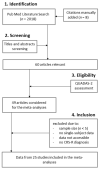Covert Cognition in Disorders of Consciousness: A Meta-Analysis
- PMID: 33276451
- PMCID: PMC7759773
- DOI: 10.3390/brainsci10120930
Covert Cognition in Disorders of Consciousness: A Meta-Analysis
Abstract
Covert cognition in patients with disorders of consciousness represents a real diagnostic conundrum for clinicians. In this meta-analysis, our main objective was to identify clinical and demographic variables that are more likely to be associated with responding to an active paradigm. Among 2018 citations found on PubMed, 60 observational studies were found relevant. Based on the QUADAS-2, 49 studies were considered. Data from 25 publications were extracted and included in the meta-analysis. Most of these studies used electrophysiology as well as counting tasks or mental imagery. According to our statistical analysis, patients clinically diagnosed as being in a vegetative state and in a minimally conscious state minus (MCS-) show similar likelihood in responding to active paradigm and responders are most likely suffering from a traumatic brain injury. In the future, multi-centric studies should be performed in order to increase sample size, with similar methodologies and include structural and functional neuroimaging in order to identify cerebral markers related to such a challenging diagnosis.
Keywords: cognitive motor dissociation; consciousness; covert cognition; minimally conscious state; severe brain injury; vegetative state.
Conflict of interest statement
The authors declare no conflict of interest.
Figures




